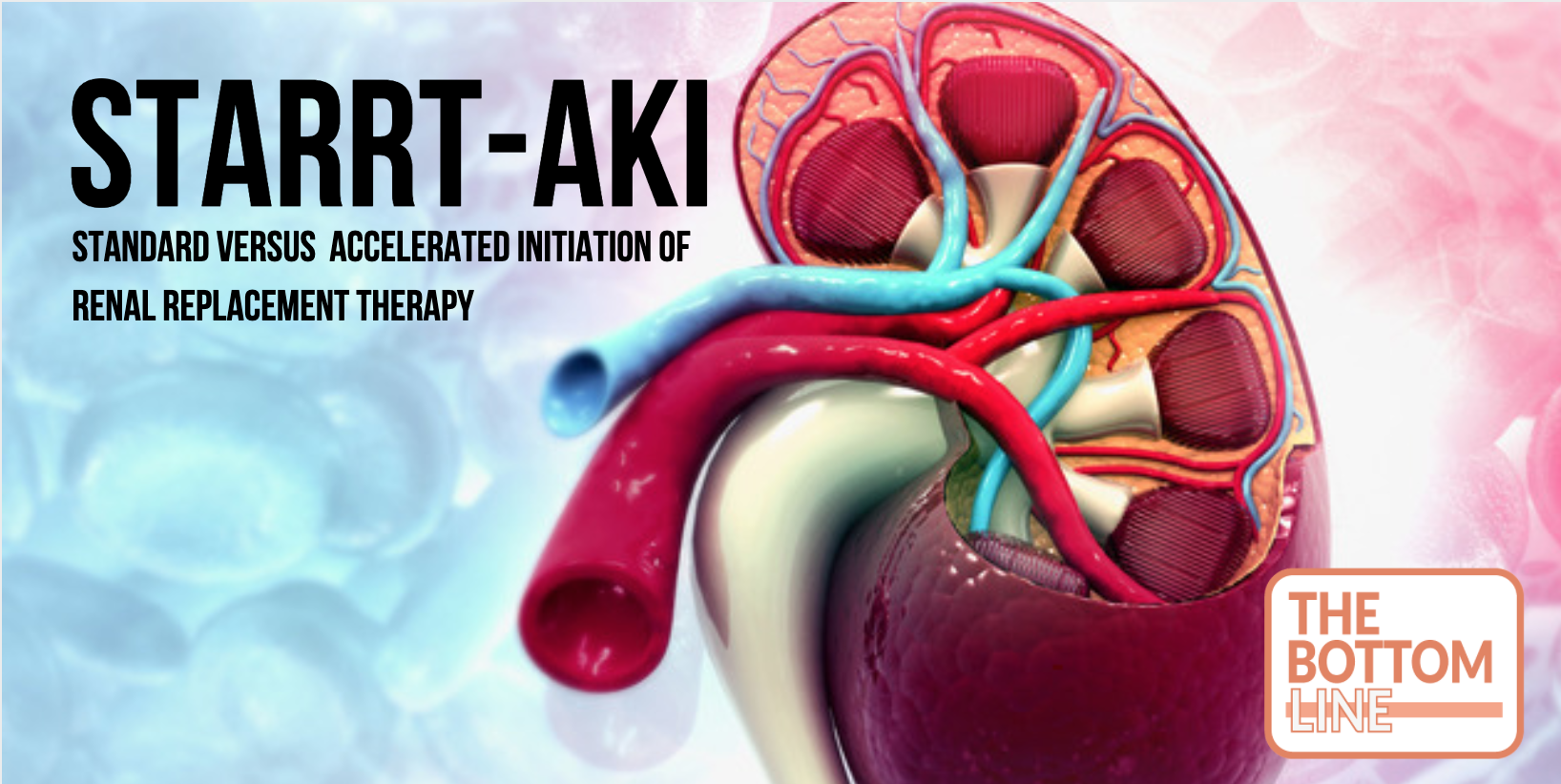STARRT-AKI

Standard versus Accelerated Initiation of Renal Replacement Therapy
Wald R, Bagshaw S. NEJM July 16 2020 doi:10.1056/NEJMoa2000741
Clinical Question
- In critically ill patients with severe acute kidney injury, does accelerated initiation of renal replacement therapy compared to standard initiation improve 90 day survival?
Background
- Acute Kidney Injury (AKI) is common in critically ill patients and some case series suggest up to 2/3rds of ICU patients develop some degree of renal impairment. Up to 50% of these patients may need dialysis which increases the complexity and cost of the care of the critically ill. Patients with critical illness and AKI have a high mortality.
- The purported rationale for early dialysis include: achieving optimal fluid balance via ultrafiltration, removal of toxic solutes that may mitigate the inflammatory milieu and correcting metabolic acidosis that may contribute to haemodynamic instability
- The purported rationale for delaying dialysis include: less procedural related risk to the patient, avoidance in some situations of an unnecessary intervention if the patient’s renal function improves spontaneously, resource rationing and avoidance of iatrogenic hypovolaemia from excessive ultrafiltration.
- Previously, there have been several trials conducted exploring the optimal timing of renal replacement therapy.
- The AKIKI trial looked at a predominantly medical cohort of patients with AKI & consequent metabolic derangement, and randomised them to early or late dialysis. At Day 60, there was no difference in mortality. Patients in this trial could receive intermittent or continuous dialysis.
- The ELAIN trial looked at a predominantly surgical cohort of patients with AKI (KDIGO stage 3) and randomised to early or late dialysis. The hazard ratio of death at day 90 was 0.66 in favour of the early initiation strategy (95% CI 0.45 to 0.97; p-value = 0.03). However, the fragility of this trial was 3.
- The IDEAL trial studied patients with septic shock and acute kidney injury. This randomised controlled trial that was stopped early due to futility, found no difference in mortality with the use of early vs. delayed renal replacement therapy
Design
- The STARRT-AKI trial (STandard versus Accelerated Initiation of Renal Replacement Therapy in Acute Kidney Injury trial)
- Open-labeled
- Randomised controlled trial. Participants were randomised 1:1 to accelerated versus standard initiation of RRT
- Variable block sizes and stratified to centre
- Allocation concealment via a web-based randomisation system
- Trial protocol and statistical analysis plan published prior to publication
- The trial was powered at 90% to detect an absolute difference of 6% between groups, based on a 90-day mortality of 40% in the standard group. Given this, the sample size was calculated at 2866 patients and increased to 3000 to account for attrition, eg loss to follow-up
- Pre-specified subgroups were patient sex, eGFR, surgical patients, geographical region, septic patients, SAP II score
- Written informed consent was obtained from the patient or substitute decision maker in keeping with the individual institutional standards
Setting
- Multi-national: 15 countries
- Multi-centre: 168 sites
- Patients were randomised from October 2015 to September 2019
Population
- Inclusion:
- >18 years
- Admission to an ICU
- AKI defined as Cr>100umol/L in women and Cr>130umol/L in men and had not declined by >27umol/l in 48 hours
- Evidence of severe AKI with at least 1 of the following 3:
- > 2-fold increase in creatinine from baseline
- Cr >354umol/L and >27umol/L above baseline creatinine
- Urine output <6ml/kg in 12 hours
- Exclusion:
- K >5.5mmol/L
- HCO3 <15mmol/L
- A drug overdose that necessitated dialysis
- Lack of commitment to provide RRT due to treatment limitations
- Any RRT in last 2 months
- Kidney transplant in last year
- Known pre-hospital ESRF with eGRF <20ml/min/1.73m2
- Presence of renal obstruction, rapidly progressive GN, vasculitis, thrombotic microangiopathy or AIN
- Once all inclusion and no exclusion criteria were met the patient could be randomised to the trial providing there was true clinician equipoise, ie it was not felt that immediate RRT was mandated or that deferred RRT was mandated. More than 7000 patients were excluded at this point due to lack of equipoise
- Once all inclusion and no exclusion criteria were met this marked a time point and consent needed to be obtained within 12 hours. Randomisation to the accelerated or standard arm then occurred.
- 3021 patients:1512 to accelerated arm, 1507 to standard arm
- 2927 patients; 1465 and 1462 patients were analysed for the primary outcome (modified intention-to-treat-analysis) as a total of 42 patients were either lost to follow up or withdrew consent.
- The baseline characteristics were similar between groups with 75% of patients mechanically ventilated and the mean Creatinine at randomisation 300umol/L
Intervention
- Patients randomised to the accelerated arm needed to commence continuous renal replacement therapy within 12 hours of randomisation
- 96.8% received dialysis
- The average time to commencement was 6 hours
- The average creatinine at time of commencement was 327umol/L and fluid balance positive 2714ml
Control
- Clinicians caring for patients randomised to the standard group were discouraged from commencing RRT unless:
- Persistent AKI, with Cr >50% the value recorded at randomisation
- AND one or more of:
-
- K+>6mmol/L
- pH < 7.2 or HCO3 <12mmol/L
- Fluid overload causing respiratory compromise (PaO2/FiO2<200)
- Persistent AKI for >72 hours from randomisation
- There was no obligation to commence RRT in the standard group arm even if the above criteria were met, eg if K is 6.3mmol/L, the clinician could manage it with medical therapy. Conversely, RRT could be commenced at any time deemed suitable based on the judgement of the attending clinician
- 61.8% of patients in the standard group received dialysis
- The average creatinine at the time of RRT commencement was 433umol/L and fluid balance positive 5893ml
Management common to both groups
- The modality of RRT was at the discretion of the treating physician (there were guidelines provided): Comparing the accelerated vs standard groups, most received continuous RRT (68.4% vs 70.6%), then IHD (27% vs 25.3%), then SLED (4.6% vs 4.1%)
- Citrate was the most common form of circuit anticoagulation
- RRT would continue until one of the following was encountered
- Death
- Withdrawal of life-support
- Kidney Function Recovered
Outcome
- Primary outcome: 90 Day Mortality (Accelerated vs Standard)
- NO SIGNIFICANT DIFFERENCE 643/1465 (43.9%) vs 639/1462 (43.7%) RR= 1, (95% CI 0.93-1.09), p=0.92 (modified ITT analysis)
- Adjusted OR 1.05 (95% CI 0.9-1.23) [This took into account baseline characteristics of the patients]
- Secondary outcome: (Accelerated vs Standard) included:
- Significant difference in:
- Dependence on RRT at Day 90 after randomisation (10.4% vs 6%), RR 1.74 (95% CI 1.24-2.43)
- Patients in the accelerated group had a shorter ICU stay than the standard group (9 days vs 10 days)
- No significant difference in:
- Composite of all cause mortality and RRT dependence at D90
- Major adverse kidney event (composite of death, RRT dependence or sustained reduction in kidney function)
- eGFR at D90
- Albuminuria at D90
- Mortality in ICU, D28, hospital
- RRT free days at D90
- Mechanical ventilation free days at D28
- Vasoactive therapy-free days through D28
- Significant difference in:
- Sub-groups: there was no significant difference in any of the pre-specified subgroups
- Adverse events were more common in the accelerated arm (23% v 16.5%), particularly hypotension and hypophosphataemia
- Serious adverse events were not significantly different (1% vs 0.5%)
Authors’ Conclusions
- In critically ill patients with severe acute kidney injury, an accelerated strategy for the initiation of renal-replacement therapy did not result in a lower mortality at 90 days than a standard strategy
Strengths
- Allocation concealment, intention to treat analysis, blinding of outcome assessors, near-complete follow-up (internal validity)
- Stratification by centre and allocation in variable block size (allowing the clinician to have little chance of predicting the allocation prior to randomisation)
- Patients were analysed by the group they were allocated to even thought there was a 7.5% cross-over in therapies between groups
- Pragmatic design which reflects the real world: if the clinician did not have absolute equipoise regarding providing accelerated or standard provision of RRT then they were not included in the trial
- Clinically meaningful outcomes
- The funding organisations and partners were not involved in the design, implementation, management of the trial, analysis of data or publication
- The trial results are widely applicable as patients were recruited from many different ICUs in many different countries (external validity)
- There was a clear differentiation between groups in term of creatinine and fluid balance at the time of RRT commencement
- There were 3 interim analyses conducted to confirm that continuation of the trial was safe
Weaknesses
- Equipoise is difficult to define: it would be useful to see the data on the patients whom were excluded because the treating clinician felt accelerated or delayed RRT was mandated
- It will be interesting to see the planned economic analysis of STARRT-AKI
The Bottom Line
- There appears to be no benefit in starting renal replacement in an accelerated fashion
- In addition early dialysis appears to increase the risk of dependence on long term renal replacement therapy raising the possibility these patients are of risk of dialysis induced kidney injury
External Links
Metadata
Summary author: Celia Bradford
Summary date: 15/7/20
Peer-review editor: Adrian Wong




Hi,
Thanks for good analysis. However, there might be a small error in definition on Inclusion criteria.
In the original article: ´kidney dysfunction (serum creatinine level, ≥1.13 mg per deciliter [100 μmol per liter] in women and ≥1.47 mg per deciliter [130 μmol per liter] in men) ´
And in Your analysis:` AKI defined as Cr>100umol/L in men and Cr>130umol/L in women and had not declined by >27umol/l in 48 hours`
If I understand correctly, definion has been swiched in man and female.
Thanks Timo
All corrected
BWs
Steve
Excellent summary.
A potentially confusing typo, however. You state that ATN is an exclusion criteria (but probably almost all the patients had tubular injury). Looks like that should read AIN (interstitial nephritis).
Keep up the awesome work.
Pedro
Thanks for picking that up! You are right and I have updated the summary. Celia
I wonder how the mortality rate was in those patients in the standatd strategy group who eventually required RRT. In AKIKI and IDEAL-ICU, these “late-RRT” patients had the worst survival probability.